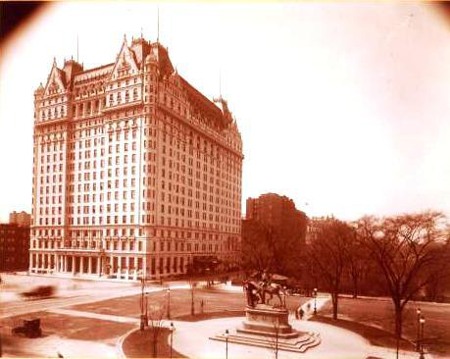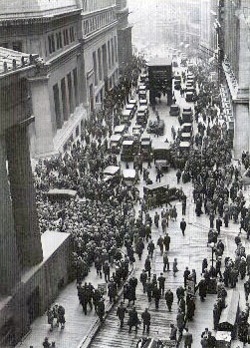The Great Gatsby Contents
Urbanisation and modernity
Population migration
Post-war America experienced a boom period, with rising prosperity and a demand for workers in manufacturing and the newly important ‘white collar’ office jobs. Social change was accelerated in cities, whilst traditional rural communities were broken down by the increased migration to urban areas.
New York, Chicago, Los Angeles, Washington and New Orleans were all growing rapidly. In New York and Chicago, skyscrapers were an expression of the confidence and ambition of this period. There was competition among New York architects to build the tallest building, leading to the creation of the Chrysler Building (1930) and the Empire State Building (1931).
Locations in Gatsby
 The nineteen-storey Plaza Hotel in New York (built 1907) was considered a skyscraper at the time, and is used by Fitzgerald as the setting for the confrontation between Tom, Daisy and Gatsby, which leads directly to tragedy. Nick notes several landmarks of New York City, including Pennsylvania Station, Queensboro Bridge, the Murray Hill Hotel and the Metropole Hotel. However the elegance of these impressive locations is undercut by his comment on the sense of ‘haunting loneliness’ and exclusion felt in the midst of this busy and ‘restless’ splendour.
The nineteen-storey Plaza Hotel in New York (built 1907) was considered a skyscraper at the time, and is used by Fitzgerald as the setting for the confrontation between Tom, Daisy and Gatsby, which leads directly to tragedy. Nick notes several landmarks of New York City, including Pennsylvania Station, Queensboro Bridge, the Murray Hill Hotel and the Metropole Hotel. However the elegance of these impressive locations is undercut by his comment on the sense of ‘haunting loneliness’ and exclusion felt in the midst of this busy and ‘restless’ splendour.
Technological progress
Telephones
Several new inventions were becoming more widely available in this period. In terms of communications, telegrams had been used for much of the nineteenth century, enabling more rapid communication than letters, but now the telephone was an instant medium, enabling business and personal interactions to develop much more quickly. The telephone was a more private form of communication than the telegram, since the conversation could be conducted without a third party being required, although it was possible for operators to listen to calls. Once the telephone exchange was invented and developed in the 1870s, widespread use became possible and, from the 1920s onwards, long distance calls were common.
Cars
There were also major developments in travel, as the development of the motor car led to its increasing use and availability in the early twentieth century. Most importantly, the development of the production line allowed Henry Ford to manufacture cars more cheaply on a large scale. The Ford ‘Model T’ was within the financial reach of the ‘average man’.
The cars in The Great Gatsby are exclusive, identifiable as symbols of elevated social status: Gatsby’s creamy-yellow Rolls Royce, Tom’s blue coupé and the limousine carrying ‘three modish negroes’ which was driven by a white chauffeur.
Cameras and movies
Photography and cinematography were developing too. The Great Gatsby highlights this by presenting the photographer Mr McKee (‘like a photograph of a man of action’) being somewhat mocked for his pretension to artistry. Meanwhile, silent movies were becoming popular in the 1920s and Hollywood grew to dominate the industry globally.
The stock market
 The concept of stocks, shares and particularly bonds was relatively new for the post-war generation. When Nick decides to be a ‘bond man’, he has to learn about the business in books. Speculation and the growth of a consumer credit culture meant that financial and economic growth was possible and, while confidence was high, this seemed to make financial sense. However, Nick’s comment that New York was ‘built with a wish out of non-olfactory money’ seems to point to the insubstantiality of this economy. The Wall Street Crash of 1929 was the reverse of the boom: a fall in confidence led to panic and a downward spiral into the economic Depression of the 1930s.
The concept of stocks, shares and particularly bonds was relatively new for the post-war generation. When Nick decides to be a ‘bond man’, he has to learn about the business in books. Speculation and the growth of a consumer credit culture meant that financial and economic growth was possible and, while confidence was high, this seemed to make financial sense. However, Nick’s comment that New York was ‘built with a wish out of non-olfactory money’ seems to point to the insubstantiality of this economy. The Wall Street Crash of 1929 was the reverse of the boom: a fall in confidence led to panic and a downward spiral into the economic Depression of the 1930s.
In The Great Gatsby, Fitzgerald’s younger characters seem to be involved with this kind of financial risk-taking, while his older characters are associated with more concrete economies (wholesale hardware, gold and silver). Furthermore, Wolfsheim and Gatsby’s connections seem to be involved in criminal dealings involving bonds, as we see with Slagle’s conversation on the phone in the final chapter, which tarnishes the image of the stock market as inherently untrustworthy.
Recently Viewed
Scan and go

Scan on your mobile for direct link.